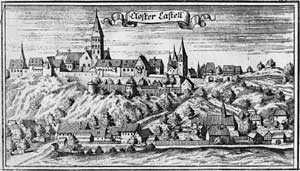Kastl Abbey
- View a machine-translated version of the German article.
- Machine translation, like DeepL or Google Translate, is a useful starting point for translations, but translators must revise errors as necessary and confirm that the translation is accurate, rather than simply copy-pasting machine-translated text into the English Wikipedia.
- Do not translate text that appears unreliable or low-quality. If possible, verify the text with references provided in the foreign-language article.
- You must provide copyright attribution in the edit summary accompanying your translation by providing an interlanguage link to the source of your translation. A model attribution edit summary is
Content in this edit is translated from the existing German Wikipedia article at [[:de:Kloster Kastl]]; see its history for attribution. - You may also add the template
{{Translated|de|Kloster Kastl}}to the talk page. - For more guidance, see Wikipedia:Translation.

Kastl Abbey (German: Kloster Kastl) is a former Benedictine monastery in Kastl in the Upper Palatinate, Bavaria.
History
The monastery, dedicated to Saint Peter, was founded in 1103, or shortly before, by Count Berengar II of Sulzbach together with Frederick and Otto, Counts of Kastl-Habsberg.
It was dissolved in 1563 in the course of the Reformation, but re-established as a Catholic monastery in 1625. From 1636 the building was used by the Jesuits, from 1773 by the Knights Hospitallers. Dissolved again in 1803, it was the seat of the Provincial Court until 1862.
From 1958 to 2006 the buildings housed a Hungarian secondary boarding school, now closed.
Princess Anna

Anna, daughter of Emperor Louis IV, died here on 29 January 1319 aged 18 months. Her body was not taken to Munich but was entombed in the monastery. In 1715 the body was removed from its tomb and kept in an oak cupboard. Later, preserved as a mummy, it lay in a shrine in the entrance hall to the monastery church, where it could be viewed. The body of the princess was recently returned to its tomb to protect it from light damage and a large photo is on display instead.
See also
References
Further reading
- Georg Dehio: Handbuch der Deutschen Kunstdenkmäler. Bayern V: Regensburg und die Oberpfalz (ed. Jolanda Drexler, Achim Hubel, Astrid Debold-Kritter et al.), München/Berlin 1991, pp. 238–246
- Stephan Haering: Kastl, Kloster(article). In: Lexikon für Theologie und Kirche, 3rd edn., vol. 5 (1996), col. 1287
- Josef Hemmerle: Die Benediktinerklöster in Bayern (Germania Benedictina 2), Augsburg 1970, pp. 125–129
- Rudolf Wiesneth: Pfalzgräfliche Wirkungsstätten. In: Hans Fischer, Manfred Kindler, Theo Männer, Peter Pauly, Otto Reimer, Rudolf Wisneth (eds.): Festschrift zum Pfalzgraf-Johann-Jahr 1983. Neunburg vorm Wald: Schmiedl 1983, pp. 60–68
External links
- Klöster in Bayern (in German)
- Prinzessin Anna (in German)
- Kastl Hungarian School Alumni Association (in Hungarian)
49°22′09″N 11°41′00″E / 49.36917°N 11.68333°E / 49.36917; 11.68333
- v
- t
- e
 | This article about a Christian monastery, abbey, priory or other religious house is a stub. You can help Wikipedia by expanding it. |
- v
- t
- e












